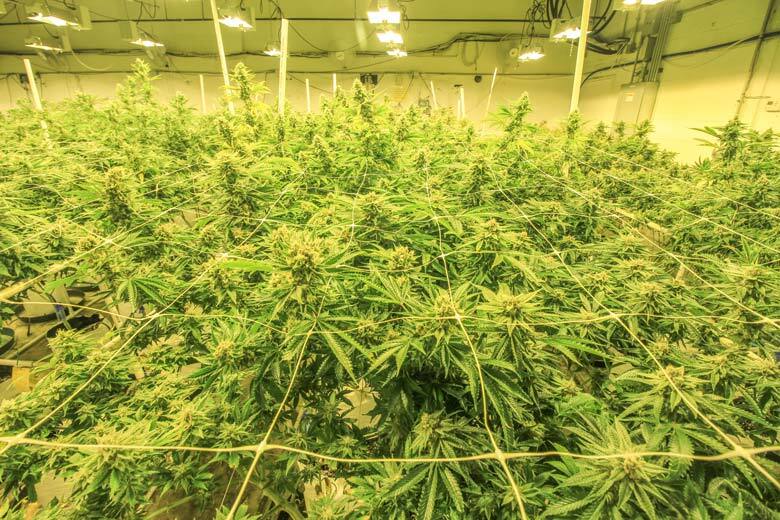
How to scrog autoflowers
Not to be confused with another popular growing technique, Sea of Green, Screen of Green is just that. The method uses a ‘screen’ to boost green growth, for optimal results. Using SCROG methods for autoflowering plants has been debated since the varieties emerged onto the scene. So, is Screen of Green beneficial for autoflowers? Let’s find out, as we explore everything you need to know about the SCROG technique for autoflowering cannabis plants.
What is Screen of Green
Screen of Green or SCROG, is a method of using a net or screen to promote horizontal versus vertical growth of cannabis plants. Why? We’ll get more into the benefits next, but basically to maximize optimal light exposure to the top main colas. As plants grow upward, growers install a net or screen just slightly above the plants, for the buds to grow through. After passing the screen, branches are tied and weaved through the net, manipulating their direction of growth.
Can you SCROG with autoflowers?
Yes, you can SCROG autoflowers. SCROG is possibly one of the most effective training techniques to use with autoflowering plants because it can be done gently and without causing them any stress. By carefully weaving the branches through a screen, you can optimize light penetration and encourage more even growth across the plant. SCROG is a common technique used by indoor growers with limited space, used correctly and you can squeeze multiple plants into a single 1 meter grow tent and really optimize your space efficiently.
When to start SCROG with autoflowers?
You can start your SCROG as soon as your autoflowers are strong enough to handle light training. This is usually around 3 weeks after germination. SCROG is a low stress training technique and if you are really gentle with your plants there is very little risk of damaging them. A rule of thumb size wise is if the branches of the plant can reach the edge of the pot, the plant is ready for SCROGGING.
The Benefits of Screen of Green
While the SCROG method does take additional work, and experience to perfect, it can be highly beneficial for your end results. Here’s a breakdown of common Screen of Green benefits to consider –
- Better support: When a plant’s bud or branch is provided with support, it can grow stronger. This helps optimize development, particularly when growing a high yield autoflower strain.
- Bigger buds: Again, the support provided by SCROG methods promotes stronger growth. More support, and stronger growth = bigger buds..
- Maximum energy use: Similar to Sea of Green methods , you’ll begin trimming and pruning lower growth when SCROG’ing. This diverts energy to the most important parts of the plants, further adding to bud size. Plus, you’re receiving optimal light exposure and energy to the most important part of the plant – the top canopy of main, fat colas.
- Maximizes space: Screen of Green helps to uniformize the structure of your plants, which maximizes your use of space. SCROG is also ideal for low clearance areas, or ceilings, since you can manipulate the height of the plant with the installed screen.
The Drawbacks of Screen of Green
Like anything in cannabis cultivation – advantages come with disadvantages, too. Before considering SCROG for your grow, be sure to be aware of the following drawbacks with this approach.
- Difficult with multiple varieties: Because of differing heights and plant shapes, indica and sativa varieties are not easily combined in SCROG setups. It’s best to grow the same type of plant, or even the same strain, to maintain uniformity. Sativa autoflowering strains are recommended, since they’re more apt to stretch during growth to utilize the screens, best.
- Obstructed access: As you can imagine, with a screen over the top of your plants access will be somewhat restricted. Drip irrigation systems are common for SCROG methods, for this reason, to make feeding and watering easier.
- Time dedication: With Screen of Green, you’ll have to monitor and maintain your plants more than normal. Watch growth carefully to attach any new bud growth, and keep your eye out for pests or molds that can spread easily.
How to Scrog with Autoflowering Plants
Using SCROG with autoflower plants somewhat varies from regular photoperiod varieties. Because there are no separate veg or bloom phases, it can be difficult to figure out when to install your screen. For the most part, it’s best to begin the Screen of Green method with autoflowering plants, when buds begin to appear. When that occurs, here are the steps to take and a few tips to follow for ultimate success.
- Gather the materials you plan on using, which may depend on the budget you plan to spend. Minimally, you’ll need a type of screen, scissors and stakes. Here are a few examples of common materials growers use for SCROG –
- Plastic nets or screens, chicken wire, nylon netting, hemp string, fishing line or metal wiring.
- Bamboo stakes, PVC piping, wood, metal or plastic frames.
- Secure your screen using ties to the frame, or posts about 20 to 25 inches from the top of the plants. Ideally, when your autoflowering plants are about a foot or 12 inches in height.
- As colas and branches begin to break through the screen, you’ll bend the branches beneath the screen. You can attach them horizontally with green ties for additional support. Continue this step as the plant continues to grow.
- Once your plant has significant growth above the screen, prune the bottom branches.
You’ll find as you move forward with the Screen of Green method, that you’ll develop your own groove, for what works best with the strain or space. With that said, lastly, let’s review the final precautions for SCROG methods with autoflowering plants that you should keep in mind as you go.
Autoflower SCROG Tips & Precautions
SCROG does vary slightly for autoflower varieties than for photoperiod plants. For ultimate success, bear in mind these key points –
- Topping: Normally, topping isn’t recommended for autoflowers to avoid stress to the plant. But, some growers have been experimenting with the technique and finding success. Topping plants produces additional side colas, which can be beneficial for maximizing yields.
- Avoiding stress: Again, autoflowers are more susceptible to stunted growth from too much stress. So while implementing any technique like defoliation, pruning, or topping, go slow at first to watch the overall health of your plant.
- Optimize airflow: Optimal airflow is also vital for the health of SCROG plants since they grow tightly together. Defoliating lower branches will help, ensure you install fans or an air exhaust system to keep a good flow of fresh air.
What is the best spacing for SCROG nets?
With autoflowers you can usually get away with about 2 to 4 inches between each square on the screen. This spacing allows sufficient room for branches to be gently woven through the screen without causing damage. By maintaining this distance, you ensure that each branch plenty of light and air circulation.
Does SCROG yield more with autoflowers?
Yes, using the SCROG technique will allow your autoflowers to yield more. By using a SCROG net, you can control the structure of your autoflowers to create a wide, even canopy that exposes more of the buds to light. This increased light exposure will boost photosynthesis, allowing your autos to grow bigger and faster. Autoflowers perform particularly well from SCROG because it compensates for their smaller size and shorter veg and flowering phases, allowing for more light absorption during their short growth cycle.
How many plants can you fit per square meter with a SCROG net?
You should be able to fit 4 to 6 autoflower plants per square meter with a SCROG net setup. The spacing of your plants also depends on the strain you are growing, if you choose a large plant such as Auto Pounder, then maybe 4 would be best. But with smaller, more compact autoflowers you should be able to fit up to 6 plants. When you are using a SCROG net the aim is to maximise the yield of each plant by promoting even light distribution, so its important not to overcrowd your grow tent as this will cause the plants to compete for light and defeat the object of what you are trying to achieve.
Screening of Green Success
As you can see, the SCROG growing method takes some time to implement and get used to but can be worth the extra work. By providing additional support, Screen of Green is highly beneficial for maximizing space, for optimal yields. Which is even more advantageous for growing smaller autoflowering plants. So, if you’re looking to get creative with your next plot and boost results – use this information, and tips to do so wisely.
2 Replies to “How to scrog autoflowers”
Leave a Reply
You must be logged in to post a comment.

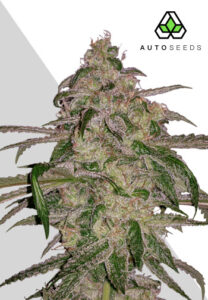

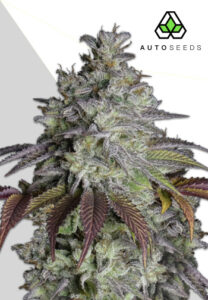
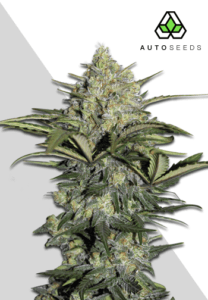
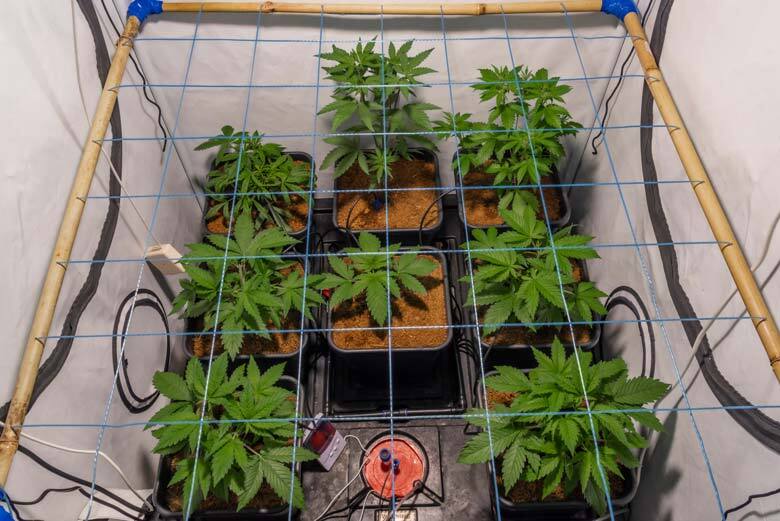
Hello. I would just like to ask a couple of questions.
– First, supposing to grow a very short and fast autoflowering, let me say around 2′ tall for 2 months of complete cycle S-H, what the mash distance between the soil and the net I should apply?
– Being the plant short, bushy and with a main, big, tall cola in the centre (I would not top the plant), what should I do with the plant top and when? Should I simply bend the top and then tie it to the mash?
Thank you so much.
Hi,
– Normally you would want your SCROG net about 20-30cm above the top of the pots and about 30-50cm below the grow lights.
– Regarding topping, we generally don’t recommend topping autoflowers because they have much shorter veg periods and you really only have 2-3 weeks to do it and for the plant to recover before the flowering stage. That is not to say that it can’t be done, but most growers will see equal or better results from just using LST training when it comes to autoflowers, here is a link to our guide on LST training https://www.autoseeds.com/lst-autoflower/. If you are going to top an auto though, top it at the 4th node.